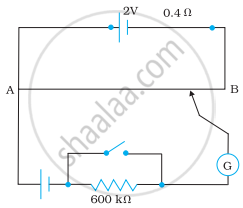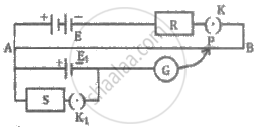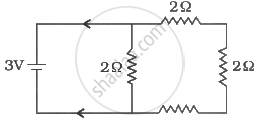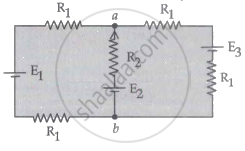Advertisements
Advertisements
प्रश्न
A potentiometer wire has resistance of per unit length of 0.1 Ω/m. A cell of e.m.f. 1.5 V balances against a 300 cm length of the wire. Find the current in the potentiometer wire.
उत्तर
Given:
σ = 0.1 Ω/m,
E = 1.5 V,
L = 300 cm = 3 m.
To find:
Current through potentiometer (I) = ?
Formulae:
- σ = R/L
- I = E/R
Calculation:
From formula (1),
R = σL
= 0.1 × 3
= 0.3 Ω
From formula (2),
I = 1.5/0.3
= 5 A
Current through the potentiometer wire is 5 A.
APPEARS IN
संबंधित प्रश्न
State the principle of working of a potentiometer.
Write two factors by which current sensitivity of a potentiometer can be increased.
On what factors does the potential gradient of the wire depend?
Figure shows a potentiometer with a cell of 2.0 V and internal resistance 0.40 Ω maintaining a potential drop across the resistor wire AB. A standard cell which maintains a constant emf of 1.02 V (for very moderate currents up to a few mA) gives a balance point at 67.3 cm length of the wire. To ensure very low currents drawn from the standard cell, very high resistance of 600 kΩ is put in series with it, which is shorted close to the balance point. The standard cell is then replaced by a cell of unknown emf ε and the balance point found similarly, turns out to be at 82.3 cm length of the wire.

(a) What is the value ε?
(b) What purpose does the high resistance of 600 kΩ have?
(c) Is the balance point affected by this high resistance?
(d) Is the balance point affected by the internal resistance of the driver cell?
(e) Would the method work in the above situation if the driver cell of the potentiometer had an emf of 1.0 V instead of 2.0 V?
(f) Would the circuit work well for determining an extremely small emf, say of the order of a few mV (such as the typical emf of a thermo-couple)? If not, how will you modify the circuit?
(i) State the principle on which a potentiometer works. How can a given potentiometer be made more sensitive?

State the underlying principle of a potentiometer ?
In the given circuit in the steady state, obtain the expressions for (a) the potential drop (b) the charge and (c) the energy stored in the capacitor, C.

A potentiometer wire of length 1 m has a resistance of 5 Ω. It is connected to a 8 V battery in series with a resistance of 15 Ω. Determine the emf of the primary cell which gives a balance point at 60 cm.
State the working principle of a potentiometer. With the help of the circuit diagram, explain how a potentiometer is used to compare the emf's of two primary cells. Obtain the required expression used for comparing the emfs.
Write the principle of working of a potentiometer. Describe briefly, with the help of a circuit diagram, how a potentiometer is used to determine the internal resistance of a given cell.
The potentiometer wire AB shown in the figure is 40 cm long. Where should the free end of the galvanometer be connected on AB, so that the galvanometer may show zero deflection?

In a potentiometer experiment, the balancing length with a resistance of 2Ω is found to be 100 cm, while that of an unknown resistance is 500 cm. Calculate the value of the unknown resistance.
When the balance point is obtained in the potentiometer, a current is drawn from ______.
State the uses of a potentiometer.
What will be the effect on the position of zero deflection if only the current flowing through the potentiometer wire is increased?
When two cells of emf's E1 and E2 are connected in series so as to assist each other, their balancing length on a potentiometer wire is found to be 2.7 m. When the cells are connected in series so as to oppose each other, the balancing length is found to be 0.3 m. Compare the emf's of the two cells.
If the potential gradient of a wire decreases, then its length ______
The instrument which can measure terminal potential difference as well as electromotive force (emf) is ______
State any one use of a potentiometer.
Which of the following instruments is not a direct reading instrument?
A 10 m long wire of resistance 20 Q is connected in series with a battery of emf 3 V and a resistance of 10 Ω. The potential gradient along the wire in V/m is ________.
The potentiometer is more sensitive, when ______.
Two cells when connected in series are balanced on 8 m on a potentiometer. If the cells are connected with polarities of one of the cell reversed, they balance on 2 m. The ratio of e.m.f's of the two cells is ____________.
The length of a potentiometer wire is L. A cell of e.m.f E is balanced at length L/3 from the positive end of the wire. If the length of wire increases by L/2, then the same cell will give balance point at length ____________.
If the e.m.f of a cell is not constant in the metre bridge experiment, then the ____________.
Which of the following is true for a potentiometer?
To determine the internal resistance of a cell by using potentiometer, the null point is at 1 m when cell is shunted by 3 Ω resistance and at a length 1.5 m when cell is shunted by 6 Ω resistance. The internal resistance of the cell is ______.
Sensitivity of a given potentiometer can be decreased by ______.
A potentiometer wire of length 100 cm and resistance 3 `Omega` is connected in series with resistance of 8 `Omega` and an accumulator of 4 volt whose internal resistance is 1 `Omega`.
In the potentiometer experiment, the balancing length with cell E1 of unknown e.m.f. is ℓ1 cm. By shunting the cell E1 with resistance 'R' which is equal to internal resistance (r) of the cell E1, the balancing length ℓ2 is ______
The current drawn from the battery in the given network is ______
(Internal resistance of the battery is neglected)

A potentiometer wire has a length of 4m and resistance of 5Ω. It is connected in series with 495 Ω resistance and a cell of e.m.f. 4V. The potential gradient along the wire is ______
If the length of potentiometer wire is increased, then the length of the previously obtained balance point will ______.
Two students X and Y perform potentiometer experiment separately and null point was obtained as shown in diagram. During the experiment, ______.
- X increases the value of R (resistance)
- Y decreases the value of S (resistance)
The position of null point obtained by students X and Y respectively.

In a potentiometer experiment when three cells A, B, C are connected in series the balancing length is found to be 740 cm. If A and B are connected in series, the balancing length is 440 cm and when B and C are connected in series, it is 540 cm. The e.m.f. of A, B, and C cells EA, EB, EC are respectively (in volt) ______
In a potentiometer experiment, for measuring internal resistance of a cell, the balance point has been obtained on the fourth wire. The balance point can be shifted to fifth wire by ______.
It is observed in a potentiometer experiment that no current passes through the galvanometer when the terminals of the cell are connected across a certain length of the potentiometer wire. On shunting the cell by a 2 Ω resistance, the balancing length is reduced to half. The internal resistance of the cell is ______.
A battery is connected with a potentiometer wire. The internal resistance of the battery is negligible. If the length of the potentiometer wire of the same material and radius is doubled then ______.
The best instrument for accurate measurement of EMF of a cell is ____________.
AB is a wire of potentiometer with the increase in value of resistance R, the shift in the balance point J will be:

A wire of resistance R is cut into two equal part. There parts are then connected in parallel. The equivalent resistance of the combination will be
What is the current I in the circuit as show in fig.

Specific resistance of a conductor increase with.
The instrument among the following which measures the e.m.f of a cell most accurately is ______
In a potentiometer circuit, a cell of EMF 1.5 V gives balance point at 36 cm length of wire. If another cell of EMF 2.5 V replaces the first cell, then at what length of the wire, the balance point occurs?
In a potentiometer circuit a cell of EMF 1.5 V gives balance point at 36 cm length of wire. If another cell of EMF 2.5 V replaces the first cell, then at what length of the wire, the balance point occurs?
For the circuit shown, with R1 = 1.0 Ω, R2 = 2.0 Ω, E1 = 2 V, and E2 = E3 = 4 V, the potential difference between the points 'a' and 'b' is approximately (in V) ______.

Two cells of same emf but different internal resistances r1 and r2 are connected in series with a resistance R. The value of resistance R, for which the potential difference across second cell is zero, is ______.
If you are provided a set of resistances 2Ω, 4Ω, 6Ω and 8Ω. Connect these resistances so as to obtain an equivalent resistance of `46/3`Ω.
In potentiometer experiment, null point is obtained at a particular point for a cell on potentiometer wire x cm long. If the length of the potentiometer wire is increased without changing the cell, the balancing length will ______. (Driving source is not changed)
In balanced meter bridge, the resistance of bridge wire is 0.1 Ω cm. Unknown resistance X is connected in left gap and 6 Ω in right gap, null point divides the wire in the ratio 2:3. Find the current drawn from the battery of 5 V having negligible resistance.
The emf of the cell of internal resistance 1.275 Ω balances against a length of 217 cm of a potentiometer wire. Find the balancing length when the cell is shunted by a resistance of 15 Ω.
